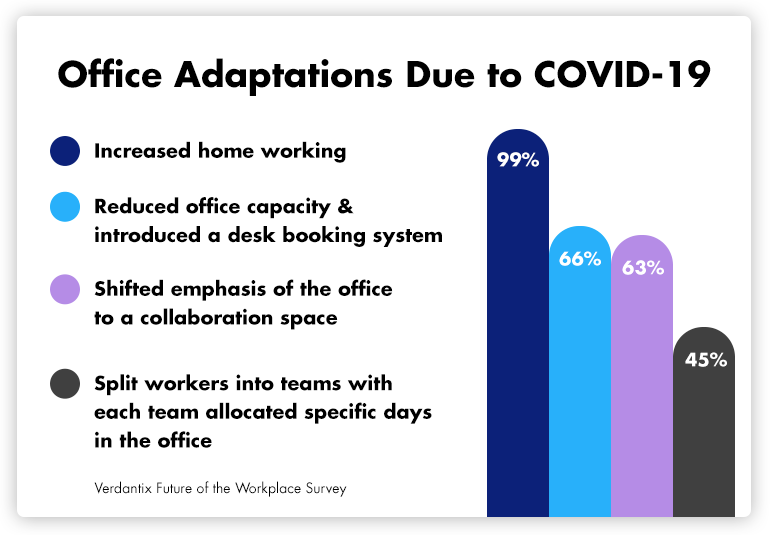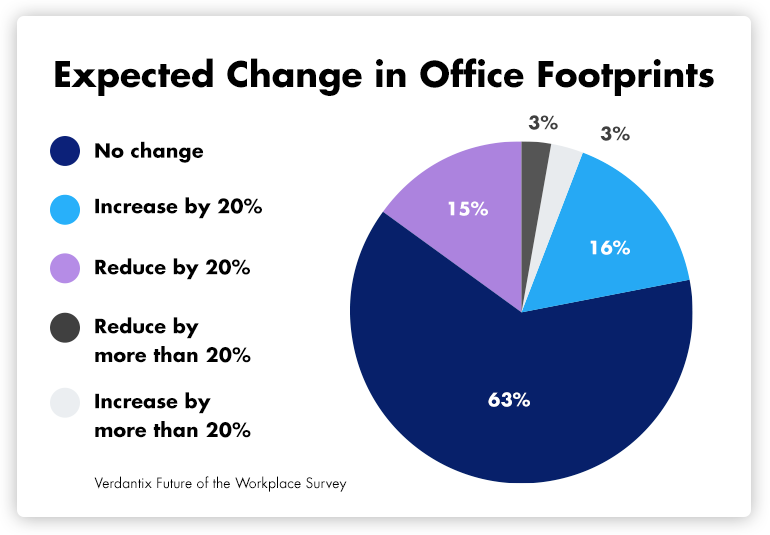7 Ways Space Management Changed Forever Since The Pandemic


With the onset of the COVID-19 pandemic, companies shifted strategic priorities to focus on improving remote collaboration and creating safer workplaces.
Now, with two-thirds of global organizations planning to reopen offices this summer, the focus has shifted to redefining the role of the workplace.
Leaders have adopted new space management strategies as a result and will likely maintain them for years to come.
The latest Verdantix report examines the most significant changes and what they mean for the future of the office.
How has space management changed in the past year?
Remote work has become a staple of the modern workplace
Prior to the pandemic, the ability to work remotely was considered a perk some companies offered to attract and retain talent, but not a necessity. Many organizations didn’t have a formal remote work policy and simply allowed it on an individual basis.
As companies sought to remain productive amid stay-at-home orders, remote work became the default. Eighty percent of companies worldwide made new investments to improve remote work, including increasing bandwidth, cloud storage, and collaboration technologies, according to a 2020 Verdantix global survey.
Now, with most employees expecting to continue working from home at least once a week, according to Gensler’s latest return-to-office survey, leaders are adopting flexible space management strategies. That includes activity-based working, hot desking, and office hoteling.
The need to limit office occupancy is driving workplace technology investments
Prior to the pandemic, maximizing space utilization was one of the primary goals of effective space management. In the past year, the introduction of CDC guidelines for physical distancing brought about the need to limit office density instead.
As workplaces began to reopen, space planners looked for ways to manage occupancy.
Some used existing technology, such as counting employee badge swipes. Others implemented visitor management systems and required employees to pre-register prior to coming into the office. This serves the dual purpose of enabling wellness checks while limiting capacity. Employees complete a short questionnaire to affirm they have no symptoms of COVID-19 and continue on with their day.
Other organizations adopted desk booking software, which makes it easy for employees to see all available workspaces and reserve them. They can choose to work where they feel most comfortable, whether it’s near a colleague or farther away from others so they can maintain distance and privacy.
As concerns about infection control dwindle with more employees receiving a COVID-19 vaccine, workplace leaders can also analyze desk booking data to better align available space with actual need.
The primary purpose of the office is collaboration
Perhaps not surprisingly, Gensler’s return-to-office survey found the primary reason employees wanted to come back to the workplace was to collaborate and socialize with others.
This means many workplace leaders are re-evaluating their space management strategies to ensure they have the right mix of spaces. Rather than traditional office designs with assigned seats, they are incorporating more conference rooms and huddle areas in their layouts.
They’re also investing in meeting room booking systems that make it easier for employees to reserve these spaces. Using digital displays or mobile apps, they can see which rooms are available and book them in advance or on the spot.
Administrators can also reconfigure conference rooms and update capacity limits to keep employees safe.
In a recent Verdantix survey, 44% of respondents said implementing new collaboration technology was a high priority for them this year.
Employees are using the office on alternating days
Many organizations want to ensure all employees have access to the office but don’t want to eliminate assigned seats. Grouping employees into assigned shifts allows them to limit capacity without rearranging their entire office.
In fact, 45% of company leaders who responded to the Verdantix Future of the Workplace Survey said they are using this strategy.

iOFFICE’s space management software and space planning feature, Space-Right, make this easy.
Workplace leaders can group employees into shifts and assign them to come in at staggered times or on alternating days. They can assign shifts based on department or need to be in the office, or simply divide everyone into random groups.
This strategy can improve space utilization beyond COVID. You can assign primarily remote employees to share a designated group of desks or allow them to reserve space as needed.
Some CRE leaders are reducing office real estate — but most are not
As the pandemic lingered, many analysts questioned whether it would mark the end of office life. While some organizations are reducing office real estate, they appear to be making these cuts with a chisel rather than an ax.
Only 18% of companies expect to reduce office space, according to the Verdantix Future of the Workplace survey, and most plan to reduce it by up to 20%.
Only 3% plan to shrink their footprint more than that.
Another 18% actually expect to increase their office footprint to reduce density and give employees more access to collaborative spaces.
The majority, 63%, plan to keep their office real estate the same.

As one senior facilities director said in the Verdantix report:
“Bringing people together and connecting them with the company’s brand, culture, and spirit is so important. We still need offices, but the space will look completely different — there’s more demand for flexible and unassigned spaces and areas for collaboration.”
Companies are making long-term reductions in office density
The amount of office space per employee has been shrinking over the past decade, from an average of 225 square feet in 2010 to just 151 square feet in 2017.
Although most companies won’t be returning to large, private offices, the pandemic slowed the overall reduction in individual space. Rather than focusing on space management strategies with a primary goal of reducing costs, companies are considering them as part of a larger quest to improve the employee experience.
Now that employees have more options to work anywhere, they won’t want to sit shoulder-to-shoulder in a crowded office. Instead, they want to work in a comfortable environment that inspires them to do their best work.
Satellite offices are becoming more popular
The pandemic caused many employees to rethink long daily commutes. Although they realize they can save thousands of dollars each year by working remotely, most still miss in-person interactions with their coworkers. This is especially important for newer employees who didn’t have time to establish strong ties before the pandemic.
To reduce office density at company headquarters and give everyone more options to collaborate, many organizations are leasing smaller office spaces in the suburbs.
This gives employees the best of both worlds. They can cut back on commuting costs while building strong relationships with their colleagues in person.
How to adjust your space management strategy for the future of work
While most organizations are keeping their existing office space, it’s clear they won’t be using it the same way.
Right now, workplace leaders are focused on reducing capacity and maintaining social distancing, but a year from now, those concerns will hopefully be a distant memory.
What will remain is employees’ desire for flexibility and the need for organizations to provide spaces that create a collaborative, cohesive company culture.
One of the best ways to prepare for these changes is to implement space management software that makes it easy to monitor utilization and update your floor plans instantly.
As workplace leaders have adopted new space management strategies, iOFFICE has added new features to our software to make planning even easier.
Take the first step to updating your office space for the future of work. Take a tour of our space management software today.
